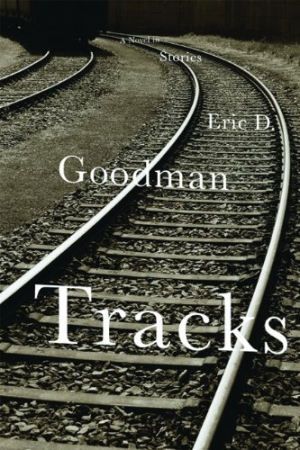Tracks
Each year, over 100,000 people ride the Cardinal, a passenger train between New York City and Chicago operated three times weekly by Amtrak. In his first novel, Eric D. Goodman chronicles the lives of a number of these passengers as they make their way through the night from Baltimore to Chicago.
Like a collection of one-act plays, each scene is a tightly scripted vignette highlighting the life of a single character. And while each chapter of the novel is a standalone story, characters have roles to play in several. A minor character in one chapter becomes the main character in another, as each person waits a turn to take center stage. The people Goodman has collected for the ride are as diverse as the countryside in this 1,100-mile train trip. Among others, he introduces us to an obsessively organized and controlled businessman, a Holocaust survivor haunted mercilessly with memories of more ominous and brutal train rides, a hit man for the mob, an archetypical, hard-living traveling salesman, and a poet.
Goodman distills the lives of his players in the solitude that is life on a train: “She hated it when he fell into silence, and he seemed to do it more and more often the more comfortable he got in their relationship.” There is no television or radio on the Cardinal to distract people from their musings or their interactions with fellow passengers. There is infrequent use of cell phones with which to contact the outside world. Goodman displays these people in their isolation and allows them to reflect on where they’re headed and where they came from: “She’d chosen the train because it was slower than the flight. She’d needed to leave Baltimore, but she was in no rush to get back to Cincinnati.”
The author has a knack for easily and quickly evoking a sense of place, here deftly describing the seasonal life in Baltimore’s Inner Harbor: “In the humid days of summer, descending from the hill into the harbor was like sinking into a familiar hot tub.” At the terminus of the journey, Chicago is more of a bit player than was Baltimore. Goodman includes passing references to the Hancock Building, which looms ominously in the background in one story, Grant Park, and similar landmarks, but his focus remains the people on the train.
The literary device of having the principal characters launched on a journey is well established, calling to mind examples as divergent as Chaucer and Zane Gray. If not done well it can be a cliche. Goodman handles the device deftly and the result is a compelling novel.
Reviewed by
John Michael Senger
Disclosure: This article is not an endorsement, but a review. The publisher of this book provided free copies of the book to have their book reviewed by a professional reviewer. No fee was paid by the publisher for this review. Foreword Reviews only recommends books that we love. Foreword Magazine, Inc. is disclosing this in accordance with the Federal Trade Commission’s 16 CFR, Part 255.

